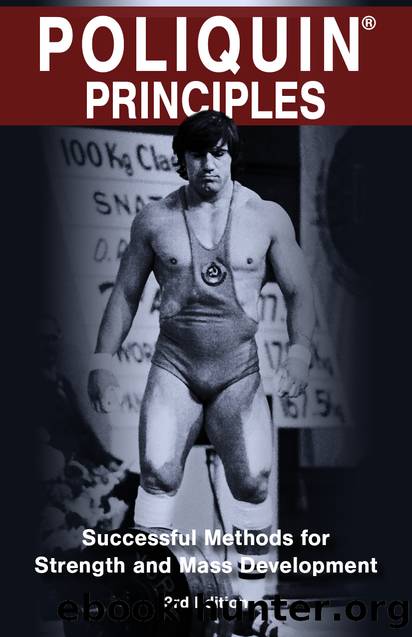Poliquin Principles by Poliquin Group

Author:Poliquin Group
Language: eng
Format: epub
Tags: Body Building and Fitness
Publisher: Poliquin Group
Published: 2016-04-12T00:00:00+00:00
Chapter 12: Calves
Sultan Rakhmanov was the 1980 Olympic Champion. Twice he broke the world record in the snatch with a best result of 443 pounds.
In all the classical statues from ancient Greece, the strongest and most powerful heroes had great calves â and with good reason. The calves are the focal point of the entire physique. At all levels of bodybuilding competitions, from local shows to the Mr. Olympia, the calves are the first place the audience and judges look to evaluate the contestants.
Yeah, right.
Although well-developed calves are an essential aspect of a symmetrical physique, they are not given much attention by the average bodybuilder, or any other athlete for that matter. The calves are not a showy muscle and are often overshadowed by the muscles of the arms, chest and shoulders. However, great calves can make a big difference on the posing dais, even creating an illusion that the thighs are bigger than they are. Arnold, for example, did not have exceptionally large thighs, but his calf development was so amazing that you seldom heard anything negative about his legs from bodybuilding writers of the day.
As for symmetry, bodybuilding guru Vince Gironda, and later Nautilus founder Arthur Jones, believed that the body is resistant to unsymmetrical development, which Jones called an âindirect effect.â As Jones said in his first book on training, Bulletin #1: âWhile it is certainly possible to build an obvious degree of disproportionate muscular size through the employment of an unbalanced program of exercises â and a training program limited to squats would be just that â there seems to be a definite limit to the degree of such disproportionate development that the body will permit; for example, it is difficult to build the size of the arms beyond a certain point, unless the large muscles of the legs are also being exercised.â
In addition to the factor of symmetry in calf development, you should consider genetics. True mesomorphs are born with naturally developed calves. Long-term kinanthropometric studies on more than 40,000 Polish students revealed that to be born with great calves, more than any other anthropometric measure (i.e., shoulder width, wrist girth, etc.), points to having an advantage in building greater overall muscle mass and strength throughout oneâs life. The most important factor for calf mass is the length of the muscle belly. The lower your muscle belly inserts on the bone, particularly the gastrocnemius, the greater your bodybuilding potential. Turn-of-the-century French naturopaths had a saying: âShort tendons, big muscles.â Itâs true.
Chris Dickerson, who won the 1982 Mr. Olympia at age 43, had low muscle bellies and reportedly trained his calves only twice a week because any more frequently would have made them too large for the rest of his body. Arthur Jones wrote in Nautilus Bulletin #2 that Dickerson was one of two surviving triplets. Jones met Dickersonâs surviving brother, and although the brother didnât train, Jones said the brother had better calves than Chris did. There was also a rumor that one finalist in a Mr.
Download
This site does not store any files on its server. We only index and link to content provided by other sites. Please contact the content providers to delete copyright contents if any and email us, we'll remove relevant links or contents immediately.
Therapeutic Modalities for Musculoskeletal Injuries, 4E by Craig R. Denegar & Ethan Saliba & Susan Saliba(7349)
Periodization Training for Sports by Tudor Bompa(7328)
Bodyweight Strength Training by Jay Cardiello(7185)
Born to Run: by Christopher McDougall(6260)
Imperfect by Sanjay Manjrekar(5411)
Wiseguy by Nicholas Pileggi(4586)
Paper Towns by Green John(4169)
Shoe Dog by Phil Knight(4167)
Bodyweight Strength Training Anatomy by Bret Contreras(4059)
The Rules Do Not Apply by Ariel Levy(3906)
Endurance: Shackleton's Incredible Voyage by Alfred Lansing(3844)
Tuesdays with Morrie by Mitch Albom(3832)
The Body: A Guide for Occupants by Bill Bryson(3801)
Yoga Anatomy by Kaminoff Leslie(3701)
The Sports Rules Book by Human Kinetics(3588)
Science and Development of Muscle Hypertrophy by Brad Schoenfeld(3578)
Dynamic Alignment Through Imagery by Eric Franklin(3489)
Bodyweight Strength Training: 12 Weeks to Build Muscle and Burn Fat by Jay Cardiello(3350)
The Ultimate Bodybuilding Cookbook by Kendall Lou Schmidt(3319)
